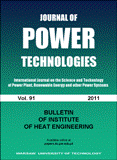Design of Fuzzy Power System Stabilizer to Improvement MG dynamic
Abstract
This study compares a controller based on fuzzy power system stabilizer (FPSS) with the complementary power system stabilizer (CPSS) for a microgrid (MG) containing an Induction Motor (IM)- Diesel Machine (DM) - Governor (GV)- Photovoltaic (PV) (IDGP). Furthermore, the linear Heffron-Phillips model is developed for MG. Using the traditional stabilizer, an specific range is calculated for changes in the MG input parameters, and a Fuzzy logic controller is designed to achieve a good performance in this wide range with a high damping ratio. The simulation results of the IDGP state space model reveals that the fuzzy logic stabilizer has an excellent ability in enhance damping torque of MG dynamic, with a linear model. The small signal stability analysis of the IDGP system has been completed with oscillatory mode trajectory and Heffron-Phillips model. In this paper the control of the voltage source converter is done using sliding mode concept. It should be noted that efficiency of the proposed controllers on damping of critical modes was examined through time domain.
Published
2025-03-03
How to Cite
NAJAFI RAVADANEGH, Sajad; MOHAMMAD AMINI, Reybin.
Design of Fuzzy Power System Stabilizer to Improvement MG dynamic.
Journal of Power Technologies, [S.l.], v. 105, n. 1, p. 15 -- 29, mar. 2025.
ISSN 2083-4195.
Available at: <https://papers.itc.pw.edu.pl/index.php/JPT/article/view/1176>. Date accessed: 30 may 2025.
Issue
Section
Electrical Engineering
Keywords
: Microgrid, Dynamic stability, Heffron-Phillips model, Fuzzy logic
Authors who publish with this journal agree to the following terms:
- Authors retain copyright and grant the journal right of first publication with the work simultaneously licensed under a Creative Commons Attribution License that allows others to share the work with an acknowledgement of the work's authorship and initial publication in this journal.
- Authors are able to enter into separate, additional contractual arrangements for the non-exclusive distribution of the journal's published version of the work (e.g., post it to an institutional repository or publish it in a book), with an acknowledgement of its initial publication in this journal.
- Authors are permitted and encouraged to post their work online (e.g., in institutional repositories or on their website) prior to and during the submission process, as it can lead to productive exchanges, as well as earlier and greater citation of published work (See The Effect of Open Access).


